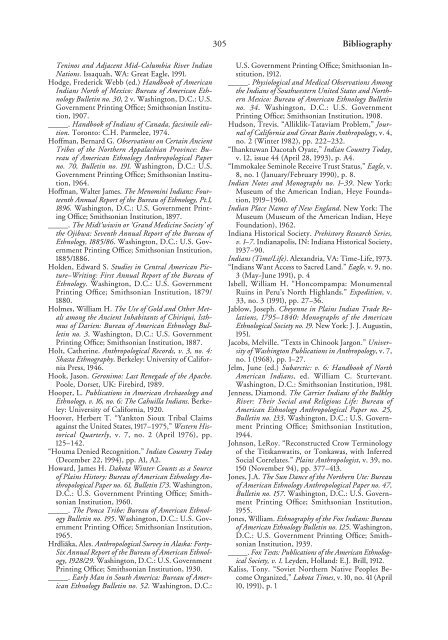You also want an ePaper? Increase the reach of your titles
YUMPU automatically turns print PDFs into web optimized ePapers that Google loves.
305 Bibliography<br />
Teninos and Adjacent Mid-Columbia River Indian<br />
Nations. Issaquah, WA: Great Eagle, 1991.<br />
Hodge, Frederick Webb (ed.) Handbook <strong>of</strong> American<br />
Indians North <strong>of</strong> Mexico: Bureau <strong>of</strong> American Ethnology<br />
Bulletin no. 30, 2 v. Washington, D.C.: U.S.<br />
Government Printing Office; Smithsonian Institution,<br />
1907.<br />
_____. Handbook <strong>of</strong> Indians <strong>of</strong> Canada, facsimile edition.<br />
Toronto: C.H. Parmelee, 1974.<br />
H<strong>of</strong>fman, Bernard G. Observations on Certain Ancient<br />
Tribes <strong>of</strong> <strong>the</strong> Nor<strong>the</strong>rn Appalachian Province: Bureau<br />
<strong>of</strong> American Ethnology Anthropological Paper<br />
no. 70, Bulletin no. 191. Washington, D.C.: U.S.<br />
Government Printing Office; Smithsonian Institution,<br />
1964.<br />
H<strong>of</strong>fman, Walter James. The Menomini Indians: Fourteenth<br />
Annual Report <strong>of</strong> <strong>the</strong> Bureau <strong>of</strong> Ethnology, Pt.1,<br />
1896. Washington, D.C.: U.S. Government Printing<br />
Office; Smithsonian Institution, 1897.<br />
_____. The Midï’wiwin or ‘Grand Medicine Society’ <strong>of</strong><br />
<strong>the</strong> Ojibwa: Seventh Annual Report <strong>of</strong> <strong>the</strong> Bureau <strong>of</strong><br />
Ethnology, 1885/86. Washington, D.C.: U.S. Government<br />
Printing Office; Smithsonian Institution,<br />
1885/1886.<br />
Holden, Edward S. Studies in Central American Picture–Writing:<br />
First Annual Report <strong>of</strong> <strong>the</strong> Bureau <strong>of</strong><br />
Ethnology. Washington, D.C.: U.S. Government<br />
Printing Office; Smithsonian Institution, 1879/<br />
1880.<br />
Holmes, William H. The Use <strong>of</strong> Gold and O<strong>the</strong>r Metals<br />
among <strong>the</strong> Ancient Inhabitants <strong>of</strong> Chiriqui, Isthmus<br />
<strong>of</strong> Darien: Bureau <strong>of</strong> American Ethnology Bulletin<br />
no. 3. Washington, D.C.: U.S. Government<br />
Printing Office; Smithsonian Institution, 1887.<br />
Holt, Ca<strong>the</strong>rine. Anthropological Records, v. 3, no. 4:<br />
Shasta Ethnography. Berkeley: University <strong>of</strong> California<br />
Press, 1946.<br />
Hook, Jason. Geronimo: Last Renegade <strong>of</strong> <strong>the</strong> Apache.<br />
Poole, Dorset, UK: Firebird, 1989.<br />
Hooper, L. Publications in American Archaeology and<br />
Ethnology, v. 16, no. 6: The Cahuilla Indians. Berkeley:<br />
University <strong>of</strong> California, 1920.<br />
Hoover, Herbert T. “Yankton Sioux <strong>Tribal</strong> Claims<br />
against <strong>the</strong> United States, 1917–1975,” Western Historical<br />
Quarterly, v. 7, no. 2 (April 1976), pp.<br />
125–142.<br />
“Houma Denied Recognition.” Indian Country Today<br />
(December 22, 1994), pp. A1, A2.<br />
Howard, James H. Dakota Winter Counts as a Source<br />
<strong>of</strong> Plains History: Bureau <strong>of</strong> American Ethnology Anthropological<br />
Paper no. 61, Bulletin 173. Washington,<br />
D.C.: U.S. Government Printing Office; Smithsonian<br />
Institution, 1960.<br />
_____. The Ponca Tribe: Bureau <strong>of</strong> American Ethnology<br />
Bulletin no. 195. Washington, D.C.: U.S. Government<br />
Printing Office; Smithsonian Institution,<br />
1965.<br />
Hrdliãka, Ales. Anthropological Survey in Alaska: Forty-<br />
Six Annual Report <strong>of</strong> <strong>the</strong> Bureau <strong>of</strong> American Ethnology,<br />
1928/29. Washington, D.C.: U.S. Government<br />
Printing Office; Smithsonian Institution, 1930.<br />
_____. Early Man in South America: Bureau <strong>of</strong> American<br />
Ethnology Bulletin no. 52. Washington, D.C.:<br />
U.S. Government Printing Office; Smithsonian Institution,<br />
1912.<br />
_____. Physiological and Medical Observations Among<br />
<strong>the</strong> Indians <strong>of</strong> Southwestern United States and Nor<strong>the</strong>rn<br />
Mexico: Bureau <strong>of</strong> American Ethnology Bulletin<br />
no. 34. Washington, D.C.: U.S. Government<br />
Printing Office; Smithsonian Institution, 1908.<br />
Hudson, Trevis. “Alliklik-Tataviam Problem,” Journal<br />
<strong>of</strong> California and Great Basin Anthropology, v. 4,<br />
no. 2 (Winter 1982), pp. 222–232.<br />
“Ihanktuwan Dacotah Oyate,” Indian Country Today,<br />
v. 12, issue 44 (April 28, 1993), p. A4.<br />
“Immokalee Seminole Receive Trust Status,” Eagle, v.<br />
8, no. 1 (January/February 1990), p. 8.<br />
Indian Notes and Monographs no. 1–39. New York:<br />
Museum <strong>of</strong> <strong>the</strong> American Indian, Heye Foundation,<br />
1919–1960.<br />
Indian Place <strong>Names</strong> <strong>of</strong> New England. New York: The<br />
Museum (Museum <strong>of</strong> <strong>the</strong> American Indian, Heye<br />
Foundation), 1962.<br />
Indiana Historical Society. Prehistory Research Series,<br />
v. 1–7. Indianapolis, IN: Indiana Historical Society,<br />
1937–90.<br />
Indians (Time/Life). Alexandria, VA: Time-Life, 1973.<br />
“Indians Want Access to Sacred Land.” Eagle, v. 9, no.<br />
3 (May-June 1991), p. 4<br />
Isbell, William H. “Honcompampa: Monumental<br />
Ruins in Peru’s North Highlands.” Expedition, v.<br />
33, no. 3 (1991), pp. 27–36.<br />
Jablow, Joseph. Cheyenne in Plains Indian Trade Relations,<br />
1795–1840: Monographs <strong>of</strong> <strong>the</strong> American<br />
Ethnological Society no. 19. New York: J. J. Augustin,<br />
1951.<br />
Jacobs, Melville. “Texts in Chinook Jargon.” University<br />
<strong>of</strong> Washington Publications in Anthropology, v. 7,<br />
no. 1 (1968), pp. 1–27.<br />
Jelm, June (ed.) Subarctic: v. 6: Handbook <strong>of</strong> North<br />
American Indians, ed. William C. Sturtevant.<br />
Washington, D.C.: Smithsonian Institution, 1981.<br />
Jenness, Diamond. The Carrier Indians <strong>of</strong> <strong>the</strong> Bulkley<br />
River: Their Social and Religious Life: Bureau <strong>of</strong><br />
American Ethnology Anthropological Paper no. 25,<br />
Bulletin no. 133. Washington, D.C.: U.S. Government<br />
Printing Office; Smithsonian Institution,<br />
1944.<br />
Johnson, LeRoy. “Reconstructed Crow Terminology<br />
<strong>of</strong> <strong>the</strong> Titskanwatits, or Tonkawas, with Inferred<br />
Social Correlates.” Plains Anthropologist, v. 39, no.<br />
150 (November 94), pp. 377–413.<br />
Jones, J.A. The Sun Dance <strong>of</strong> <strong>the</strong> Nor<strong>the</strong>rn Ute: Bureau<br />
<strong>of</strong> American Ethnology Anthropological Paper no. 47,<br />
Bulletin no. 157. Washington, D.C.: U.S. Government<br />
Printing Office; Smithsonian Institution,<br />
1955.<br />
Jones, William. Ethnography <strong>of</strong> <strong>the</strong> Fox Indians: Bureau<br />
<strong>of</strong> American Ethnology Bulletin no. 125. Washington,<br />
D.C.: U.S. Government Printing Office; Smithsonian<br />
Institution, 1939.<br />
_____. Fox Texts: Publications <strong>of</strong> <strong>the</strong> American Ethnological<br />
Society, v. 1. Leyden, Holland: E.J. Brill, 1912.<br />
Kaliss, Tony. “Soviet Nor<strong>the</strong>rn Native Peoples Become<br />
Organized,” Lakota Times, v. 10, no. 41 (April<br />
10, 1991), p. 1


















